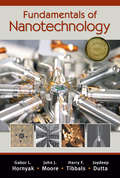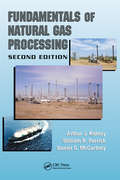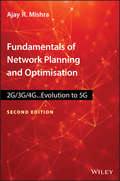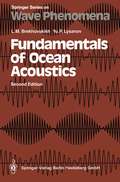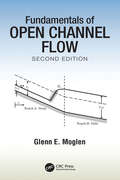- Table View
- List View
Fundamentals of Music Processing: Using Python and Jupyter Notebooks
by Meinard MüllerThe textbook provides both profound technological knowledge and a comprehensive treatment of essential topics in music processing and music information retrieval (MIR). Including numerous examples, figures, and exercises, this book is suited for students, lecturers, and researchers working in audio engineering, signal processing, computer science, digital humanities, and musicology.The book consists of eight chapters. The first two cover foundations of music representations and the Fourier transform—concepts used throughout the book. Each of the subsequent chapters starts with a general description of a concrete music processing task and then discusses—in a mathematically rigorous way—essential techniques and algorithms applicable to a wide range of analysis, classification, and retrieval problems. By mixing theory and practice, the book’s goal is to offer detailed technological insights and a deep understanding of music processing applications.As a substantial extension, the textbook’s second edition introduces the FMP (fundamentals of music processing) notebooks, which provide additional audio-visual material and Python code examples that implement all computational approaches step by step. Using Jupyter notebooks and open-source web applications, the FMP notebooks yield an interactive framework that allows students to experiment with their music examples, explore the effect of parameter settings, and understand the computed results by suitable visualizations and sonifications. The FMP notebooks are available from the author’s institutional web page at the International Audio Laboratories Erlangen.
Fundamentals of Nano-Textile Science
by Prashansa Sharma Devsuni Singh Vivek DaveFundamentals of Nano-Textile Science provides a detailed overview of advanced nano-textiles methods, techniques, and treatments along with explanations of a wide range of applications. This book places emphasis on nanotechnology-based textile enhancements that provide high durability, better affinity, and more functionality in textile material and that overcomes the limitation of conventional processes in the textile industry. The first section of the book deals with the production method of nano-textile fibers. It elaborates how nano-techniques are used for producing textile fiber and discusses various pretreatment processes of textile materials using such methods as nano-scouring, nanobiophotoscouring, nano-bleaching, nano-softening, and nano-surface activation. The second section discusses the wide range of nanofinishing applications to make textile materials antimicrobial, flame retardant, UV-protected, etc. It also discusses different techniques and treatments applied on the surface of the finished product using plasma technology or layer-by-layer deposition techniques. This section also covers nano-based textile applications such as for sports clothing, military textiles, high-performance clothing, or smart wearable high-tech nano-textiles. In the last section, the book concludes with an overview of nanotechnological advancements being used for the management of textile effluents and for removing dyes from wastewater in textile processing, focusing on the health and safety perspective of nano-textiles. The book is written by highly experienced authors in this area and provides an immensely valuable resource for scientific researchers, academics, professionals, engineers, technologists and innovators working on designing and manufacturing textile materials. The volume will be an important resource for those who are looking for innovative production technologies or the latest nanotechnology developments in the design and manufacturing of nano-textile materials. Key features: Provides a detailed theoretical overview of nano-textiles along with novel advanced techniques, methods, treatments for enhanced properties and applications of textiles. Covers relevant techniques applied on the surface of the finished textile product using plasma technology or layer-by-layer deposition techniques Introduces various nanofinishes and applications including for sports clothing, military textiles, high performance clothing or smart wearable high-tech textiles Describes wearable smart nano-textile parameters, types of materials used, applications, and future innovations for prevention of hazards and pandemic diseases Explores innovative methods and treatments for management or removal of textile waste
Fundamentals of Nanomechanical Resonators
by Silvan Schmid Luis Guillermo Villanueva Michael Lee RoukesThis authoritative book introduces and summarizes the latest models and skills required to design and fabricate nanomechanical resonators with a focus on nanomechanical sensing. It also establishes the theoretical foundation for courses on micro and nanomechanics. This book takes an applied approach to nanomechanics, providing a complete set of mechanical models, including strings and membrane resonators. Also discussed are quality factors, noise issues, transduction techniques, nanomechanical sensing, fabrication techniques, and applications for all common nanomechanical resonator types. It is an ideal book for students and researchers working with micro and nanomechanical resonators.
Fundamentals of Nanomechanical Resonators
by Silvan Schmid Luis Guillermo Villanueva Michael Lee RoukesNow in an updated second edition, this classroom-tested textbook introduces and summarizes the latest models and skills required to design and optimize nanomechanical resonators, taking a top-down approach that uses macroscopic formulas to model the devices. The authors cover the electrical and mechanical aspects of nanoelectromechanical system (NEMS) devices in six expanded and revised chapters on lumped-element model resonators, continuum mechanical resonators, damping, transduction, responsivity, and measurements and noise.The applied approach found in this book is appropriate for engineering students and researchers working with micro and nanomechanical resonators.
Fundamentals of Nanoscale Film Analysis
by Terry L. Alford L.C. Feldman James W. MayerFrom materials science to integrated circuit development, much of modern technology is moving from the microscale toward the nanoscale. This book focuses on the fundamental physics underlying innovative techniques for analyzing surfaces and near-surfaces. New analytical techniques have emerged to meet these technological requirements, all based on a few processes that govern the interactions of particles and radiation with matter. This book addresses the fundamentals and application of these processes, from thin films to field effect transistors.
Fundamentals of Nanoscaled Field Effect Transistors
by Amit ChaudhryFundamentals of Nanoscaled Field Effect Transistors gives comprehensive coverage of the fundamental physical principles and theory behind nanoscale transistors. The specific issues that arise for nanoscale MOSFETs, such as quantum mechanical tunneling and inversion layer quantization, are fully explored. The solutions to these issues, such as high-κ technology, strained-Si technology, alternate devices structures and graphene technology are also given. Some case studies regarding the above issues and solution are also given in the book.
Fundamentals of Nanotechnology
by Gabor L. Hornyak John J. Moore H. F. Tibbals Joydeep DuttaWINNER 2009 CHOICE AWARD OUTSTANDING ACADEMIC TITLE! Nanotechnology is no longer a subdiscipline of chemistry, engineering, or any other field. It represents the convergence of many fields, and therefore demands a new paradigm for teaching. This textbook is for the next generation of nanotechnologists. It surveys the field’s broad landscape, exploring the physical basics such as nanorheology, nanofluidics, and nanomechanics as well as industrial concerns such as manufacturing, reliability, and safety. The authors then explore the vast range of nanomaterials and systematically outline devices and applications in various industrial sectors. This color text is an ideal companion to Introduction to Nanoscience by the same group of esteemed authors. Both titles are also available as the single volume Introduction to Nanoscience and Nanotechnology Qualifying instructors who purchase either of these volumes (or the combined set) are given online access to a wealth of instructional materials. These include detailed lecture notes, review summaries, slides, exercises, and more. The authors provide enough material for both one- and two-semester courses.
Fundamentals of Natural Gas Processing
by Arthur J. Kidnay William R. Parrish Daniel G. McCartneyOffering indispensable insight from experts in the field, Fundamentals of Natural Gas Processing, Second Edition provides an introduction to the gas industry and the processes required to convert wellhead gas into valuable natural gas and hydrocarbon liquids products. The authors compile information from the literature, meeting proceedings, and the
Fundamentals of Natural Gas Processing, Third Edition
by Arthur J. Kidnay William R. Parrish Daniel G. McCartneyOffering indispensable insight from experts in the field, Fundamentals of Natural Gas Processing, Third Edition provides an introduction to the gas industry and the processes required to convert wellhead gas into valuable natural gas and hydrocarbon liquids products including LNG. The authors compile information from the literature, meeting proceedings, short courses, and their own work experiences to give an accurate picture of where gas processing technology stands today as well as to highlight relatively new technologies that could become important in the future. The third edition of this bestselling text features updates on North American gas processing and changing gas treating requirements due to shale gas production. It covers the international nature of natural gas trade, LNG, economics, and more. To help nonengineers understand technical issues, the first 5 chapters present an overview of the basic engineering concepts applicable throughout the gas, oil, and chemical industries. The following 15 chapters address natural gas processing, with a focus on gas plant processes and technologies. The book contains 2 appendices. The first contains an updated glossary of gas processing terminology. The second is available only online and contains useful conversion factors and physical properties data. Aimed at students as well as natural gas processing professionals, this edition includes both discussion questions and exercises designed to reinforce important concepts, making this book suitable as a textbook in upper-level or graduate engineering courses.
Fundamentals of Natural Gas Processing, Third Edition
by Arthur J. Kidnay William R. Parrish Daniel G. McCartneyOffering indispensable insight from experts in the field, Fundamentals of Natural Gas Processing, Third Edition provides an introduction to the gas industry and the processes required to convert wellhead gas into valuable natural gas and hydrocarbon liquids products including LNG. The authors compile information from the literature, meeting proceedings, short courses, and their own work experiences to give an accurate picture of where gas processing technology stands today as well as to highlight relatively new technologies that could become important in the future. The third edition of this bestselling text features updates on North American gas processing and changing gas treating requirements due to shale gas production. It covers the international nature of natural gas trade, LNG, economics, and more. To help nonengineers understand technical issues, the first 5 chapters present an overview of the basic engineering concepts applicable throughout the gas, oil, and chemical industries. The following 15 chapters address natural gas processing, with a focus on gas plant processes and technologies. The book contains 2 appendices. The first contains an updated glossary of gas processing terminology. The second is available only online and contains useful conversion factors and physical properties data. Aimed at students as well as natural gas processing professionals, this edition includes both discussion questions and exercises designed to reinforce important concepts, making this book suitable as a textbook in upper-level or graduate engineering courses.
Fundamentals of Network Planning and Optimisation 2G/3G/4G: Evolution to 5G
by Ajay R. MishraUpdated new edition covering all aspects of network planning and optimization This welcome new edition provides comprehensive coverage of all aspects of network planning in all the technologies, from 2G to 5G, in radio, transmission and core aspects. Written by leading experts in the field, it serves as a handbook for anyone engaged in the study, design, deployment and business of cellular networks. It increases basic understanding of the currently deployed, and emerging, technologies, and helps to make evolution plans for future networks. The book also provides an overview of the forthcoming technologies that are expected to make an impact in the future, such as 5G. Fundamentals of Cellular Network Planning and Optimization, Second Edition encompasses all the technologies as well as the planning and implementation details that go with them. It covers 2G (GSM, EGPRS), 3G (WCDMA) and 4G (LTE) networks and introduces 5G. The book also looks at all the sub-systems of the network, focusing on both the practical and theoretical issues. Provides comprehensive coverage of the planning aspects of the full range of today's mobile network systems, covering radio access network, circuit and packet switching, signaling, control, and backhaul/Core transmission networks New elements in book include HSPA, Ethernet, 4G/LTE and 5G Covers areas such as Virtualization, IoT, Artificial Intelligence, Spectrum Management and Cloud By bringing all these concepts under one cover, Fundamentals of Cellular Network Planning and Optimization becomes essential reading for network design engineers working with cellular service vendors or operators, experts/scientists working on end-to-end issues, and undergraduate/post-graduate students.
Fundamentals of Network Planning and Optimisation 2G/3G/4G: Evolution to 5G
by Ajay R. MishraUpdated new edition covering all aspects of network planning and optimization This welcome new edition provides comprehensive coverage of all aspects of network planning in all the technologies, from 2G to 5G, in radio, transmission and core aspects. Written by leading experts in the field, it serves as a handbook for anyone engaged in the study, design, deployment and business of cellular networks. It increases basic understanding of the currently deployed, and emerging, technologies, and helps to make evolution plans for future networks. The book also provides an overview of the forthcoming technologies that are expected to make an impact in the future, such as 5G. Fundamentals of Cellular Network Planning and Optimization, Second Edition encompasses all the technologies as well as the planning and implementation details that go with them. It covers 2G (GSM, EGPRS), 3G (WCDMA) and 4G (LTE) networks and introduces 5G. The book also looks at all the sub-systems of the network, focusing on both the practical and theoretical issues. Provides comprehensive coverage of the planning aspects of the full range of today's mobile network systems, covering radio access network, circuit and packet switching, signaling, control, and backhaul/Core transmission networks New elements in book include HSPA, Ethernet, 4G/LTE and 5G Covers areas such as Virtualization, IoT, Artificial Intelligence, Spectrum Management and Cloud By bringing all these concepts under one cover, Fundamentals of Cellular Network Planning and Optimization becomes essential reading for network design engineers working with cellular service vendors or operators, experts/scientists working on end-to-end issues, and undergraduate/post-graduate students.
Fundamentals of Neurodegeneration and Protein Misfolding Disorders (Biological and Medical Physics, Biomedical Engineering)
by Martin BeckermanThis unique text introduces students and researchers to the world of misfolded proteins, toxic oligomers, and amyloid assemblages, and the diseases of the brain that result. During the past few years the connections between failures in protein quality control and neurological disorders have been reinforced and strengthened by discoveries on multiple fronts. These findings provide novel insights on how amyloidogenic oligomers and fibrils form, interconvert from one state to another, and propagate from cell to cell and region to region. Starting with protein folding and protein quality control basics, the reader will learn how misfolded proteins can cause diseases ranging from prion diseases to Alzheimer’s disease and Parkinson’s disease to Huntington’s disease, amyotrophic lateral sclerosis and frontotemporal lobar degeneration. Authoritative but written in a clear and engaging style, Fundamentals of Neurodegeneration and Protein Misfolding Disorders addresses one of today’s forefront areas of science and medicine. The text emphasizes the new groundbreaking biophysical and biochemical methods that enable molecular-level explorations and the conceptual breakthroughs that result. It contains separate chapters on each of the major disease classes. Special emphasis is placed on those factors and themes that are common to the diseases, especially failures in synaptic transmission, mitochondrial control, and axonal transport; breakdowns in RNA processing; the potential role of environmental factors; and the confounding effects of neuroinflammation. The book is ideal for use in teaching at the advanced undergraduate and graduate levels, and serves as a comprehensive reference for a broad audience of students and researchers in neuroscience, molecular biology, biological physics and biomedical engineering.
Fundamentals of NeuroIS: Information Systems and the Brain (Studies in Neuroscience, Psychology and Behavioral Economics)
by René Riedl Pierre-Majorique LégerThis authored volume presents the fundamentals of NeuroIS, which is an emerging subfield within the Information Systems discipline that makes use of neuroscience and neurophysiological tools and knowledge to better understand the development, use, and impact of information and communication technologies. This book is an initial guide to this new research domain. The target audience primarily comprises PhD students and researchers, but the book may also be beneficial for graduate students and practitioners.
Fundamentals of Neuromechanics (Biosystems & Biorobotics #8)
by Francisco J. Valero-CuevasThis book provides a conceptual and computational framework to study how the nervous system exploits the anatomical properties of limbs to produce mechanical function. The study of the neural control of limbs has historically emphasized the use of optimization to find solutions to the muscle redundancy problem. That is, how does the nervous system select a specific muscle coordination pattern when the many muscles of a limb allow for multiple solutions? I revisit this problem from the emerging perspective of neuromechanics that emphasizes finding and implementing families of feasible solutions, instead of a single and unique optimal solution. Those families of feasible solutions emerge naturally from the interactions among the feasible neural commands, anatomy of the limb, and constraints of the task. Such alternative perspective to the neural control of limb function is not only biologically plausible, but sheds light on the most central tenets and debates in the fields of neural control, robotics, rehabilitation, and brain-body co-evolutionary adaptations. This perspective developed from courses I taught to engineers and life scientists at Cornell University and the University of Southern California, and is made possible by combining fundamental concepts from mechanics, anatomy, mathematics, robotics and neuroscience with advances in the field of computational geometry. Fundamentals of Neuromechanics is intended for neuroscientists, roboticists, engineers, physicians, evolutionary biologists, athletes, and physical and occupational therapists seeking to advance their understanding of neuromechanics. Therefore, the tone is decidedly pedagogical, engaging, integrative, and practical to make it accessible to people coming from a broad spectrum of disciplines. I attempt to tread the line between making the mathematical exposition accessible to life scientists, and convey the wonder and complexity of neuroscience to engineers and computational scientists. While no one approach can hope to definitively resolve the important questions in these related fields, I hope to provide you with the fundamental background and tools to allow you to contribute to the emerging field of neuromechanics.
Fundamentals of Non-Thermal Processes for Food Preservation
by Snehasis Chakraborty Rishab DharThe ten chapters of this textbook, written in a simple but scientific language, encompass all the non-thermal treatments in-depth, from basic concepts to technological advances. The book provides complete study material in a single source including such pedagogical features as multiple-choice questions, solved numerical problems, and short questions. The book begins with a general introduction to the evolution of the non-thermal technique for food preservation. The fundamental mechanism of thermal inactivation of microorganisms and enzymes is discussed. In the following chapters, a set of seven non-thermal techniques have been discussed in detail.
Fundamentals of Non-Thermal Processes for Food Preservation
by Snehasis Chakraborty Rishab DharThe ten chapters of this textbook, written in a simple but scientific language, encompass all the non-thermal treatments in-depth, from basic concepts to technological advances. The book provides complete study material in a single source including such pedagogical features as multiple-choice questions, solved numerical problems, and short questions. The book begins with a general introduction to the evolution of the non-thermal technique for food preservation. The fundamental mechanism of thermal inactivation of microorganisms and enzymes is discussed. In the following chapters, a set of seven non-thermal techniques have been discussed in detail.
Fundamentals of Nonlinear Optics
by Joseph W. Haus Peter E. PowersPraise for the 1st Edition: "well written and up to date…. The problem sets at the end of each chapter reinforce and enhance the material presented, and may give students confidence in handling real-world problems." ―Optics & Photonics News "rigorous but simple description of a difficult field keeps the reader’s attention throughout…. serves perfectly for an introductory-level course." ―Physics Today This fully revised introduction enables the reader to understand and use the basic principles related to many phenomena in nonlinear optics and provides the mathematical tools necessary to solve application-relevant problems. The book is a pedagogical guide aimed at a diverse audience including engineers, physicists, and chemists who want a tiered approach to understanding nonlinear optics. The material is augmented by numerous problems, with many requiring the reader to perform real-world calculations for a range of fields, from optical communications to remote sensing and quantum information. Analytical solutions of equations are covered in detail and numerical approaches to solving problems are explained and demonstrated. The second edition expands the earlier treatment and includes: A new chapter on quantum nonlinear optics. Thorough treatment of parametric optical processes covering birefringence, tolerances and beam optimization to design and build high conversion efficiency devices. Treatment of numerical methods to solving sets of complex nonlinear equations. Many problems in each chapter to challenge reader comprehension. Extended treatment of four-wave mixing and solitons. Coverage of ultrafast pulse propagation including walk-off effects.
Fundamentals of Nonlinear Optics
by Joseph W. Haus Peter E. PowersPraise for the 1st Edition: "well written and up to date…. The problem sets at the end of each chapter reinforce and enhance the material presented, and may give students confidence in handling real-world problems." ―Optics & Photonics News "rigorous but simple description of a difficult field keeps the reader’s attention throughout…. serves perfectly for an introductory-level course." ―Physics Today This fully revised introduction enables the reader to understand and use the basic principles related to many phenomena in nonlinear optics and provides the mathematical tools necessary to solve application-relevant problems. The book is a pedagogical guide aimed at a diverse audience including engineers, physicists, and chemists who want a tiered approach to understanding nonlinear optics. The material is augmented by numerous problems, with many requiring the reader to perform real-world calculations for a range of fields, from optical communications to remote sensing and quantum information. Analytical solutions of equations are covered in detail and numerical approaches to solving problems are explained and demonstrated. The second edition expands the earlier treatment and includes: A new chapter on quantum nonlinear optics. Thorough treatment of parametric optical processes covering birefringence, tolerances and beam optimization to design and build high conversion efficiency devices. Treatment of numerical methods to solving sets of complex nonlinear equations. Many problems in each chapter to challenge reader comprehension. Extended treatment of four-wave mixing and solitons. Coverage of ultrafast pulse propagation including walk-off effects.
Fundamentals of Nuclear Science and Engineering
by J. Kenneth Shultis Richard E. FawFundamentals of Nuclear Science and Engineering, Third Edition, presents the nuclear science concepts needed to understand and quantify the whole range of nuclear phenomena. Noted for its accessible level and approach, the Third Edition of this long-time bestselling textbook provides overviews of nuclear physics, nuclear power, medicine, propulsion, and radiation detection. Its flexible organization allows for use with Nuclear Engineering majors and those in other disciplines. The Third Edition features updated coverage of the newest nuclear reactor designs, fusion reactors, radiation health risks, and expanded discussion of basic reactor physics with added examples. A complete Solutions Manual and figure slides for classroom projection are available for instructors adopting the text.
Fundamentals of Nuclear Science and Engineering
by J. Kenneth Shultis Richard E. FawFundamentals of Nuclear Science and Engineering, Third Edition, presents the nuclear science concepts needed to understand and quantify the whole range of nuclear phenomena. Noted for its accessible level and approach, the Third Edition of this long-time bestselling textbook provides overviews of nuclear physics, nuclear power, medicine, propulsion, and radiation detection. Its flexible organization allows for use with Nuclear Engineering majors and those in other disciplines. The Third Edition features updated coverage of the newest nuclear reactor designs, fusion reactors, radiation health risks, and expanded discussion of basic reactor physics with added examples. A complete Solutions Manual and figure slides for classroom projection are available for instructors adopting the text.
Fundamentals of Ocean Acoustics (Springer Series on Wave Phenomena #8)
by Leonid M. Brekhovskikh Yury P. LysanovAs man turns his attention from the overcrowded continents of this planet and explores the spaciousness of the ocean, the applications of ocean acoustics become increasingly numerous and important. This book pro- vides an up-to-date introduction to the theory of sound propagation in the ocean, with much new material having been added throughout the second edition. It includes both ray and wave treatments and considerable attention is paid to stochastic problems such as the scattering of sound at rough surfaces and random inhomogeneties. An introductory chapter that discusses the basic experimental data complements the following theoretical chapters.
Fundamentals of Open Channel Flow
by Glenn E. MoglenExposes You to Current Industry-Standard ToolsOpen channel flow is covered in essentially all civil and environmental engineering programs, usually by final-year undergraduate or graduate students studying water resources.Fundamentals of Open Channel Flow outlines current theory along with clear and fully solved examples that illustrate the concept
Fundamentals of Open Channel Flow
by Glenn E. MoglenThis second edition of Fundamentals of Open Channel Flow focuses on theory followed by clear, fully-solved examples, and practical computational tools such as spreadsheets and industry standard software. It builds on a foundation in fluid mechanics and offers the basics of a first course in open channel flow for senior undergraduates or graduate students: energy, momentum, friction, and gradually varied flow, both qualitative and quantitative. This edition provides more coverage of design applications, including culvert design, a wider range of channel shapes, and an update of the US Corps of Engineers’ HEC-RAS program. It shows how a few simple equations can solve a range of basic problems. The energy-depth and momentum-depth relationships are examined graphically and the book's website offers unique animations showing actual flow dynamics of some transient flow problems, as well as solutions to end-of-chapter problems and PowerPoint slides for instructors.
Fundamentals of Open Channel Flow
by Glenn E. MoglenThis second edition of Fundamentals of Open Channel Flow focuses on theory followed by clear, fully-solved examples, and practical computational tools such as spreadsheets and industry standard software. It builds on a foundation in fluid mechanics and offers the basics of a first course in open channel flow for senior undergraduates or graduate students: energy, momentum, friction, and gradually varied flow, both qualitative and quantitative. This edition provides more coverage of design applications, including culvert design, a wider range of channel shapes, and an update of the US Corps of Engineers’ HEC-RAS program. It shows how a few simple equations can solve a range of basic problems. The energy-depth and momentum-depth relationships are examined graphically and the book's website offers unique animations showing actual flow dynamics of some transient flow problems, as well as solutions to end-of-chapter problems and PowerPoint slides for instructors.






